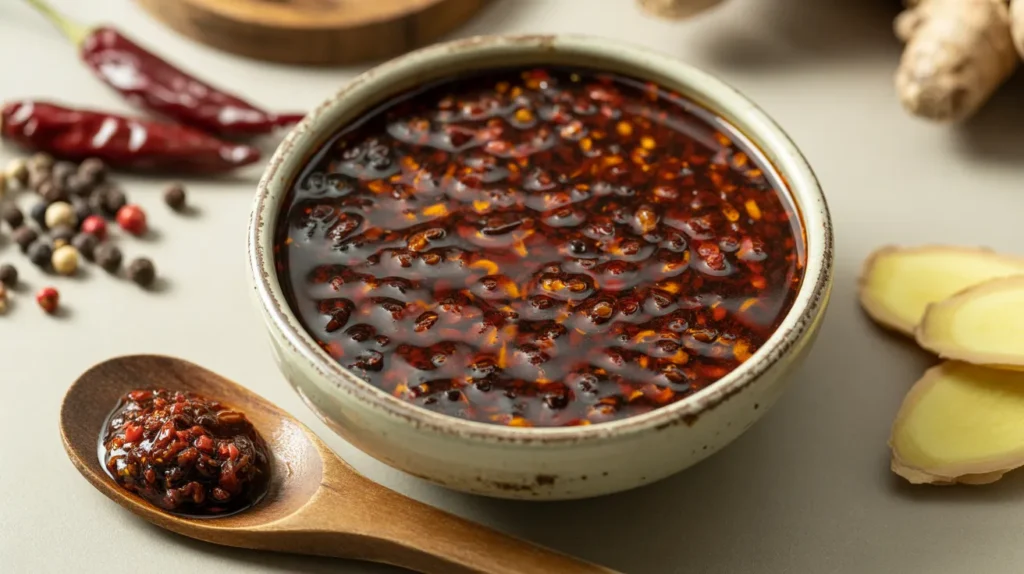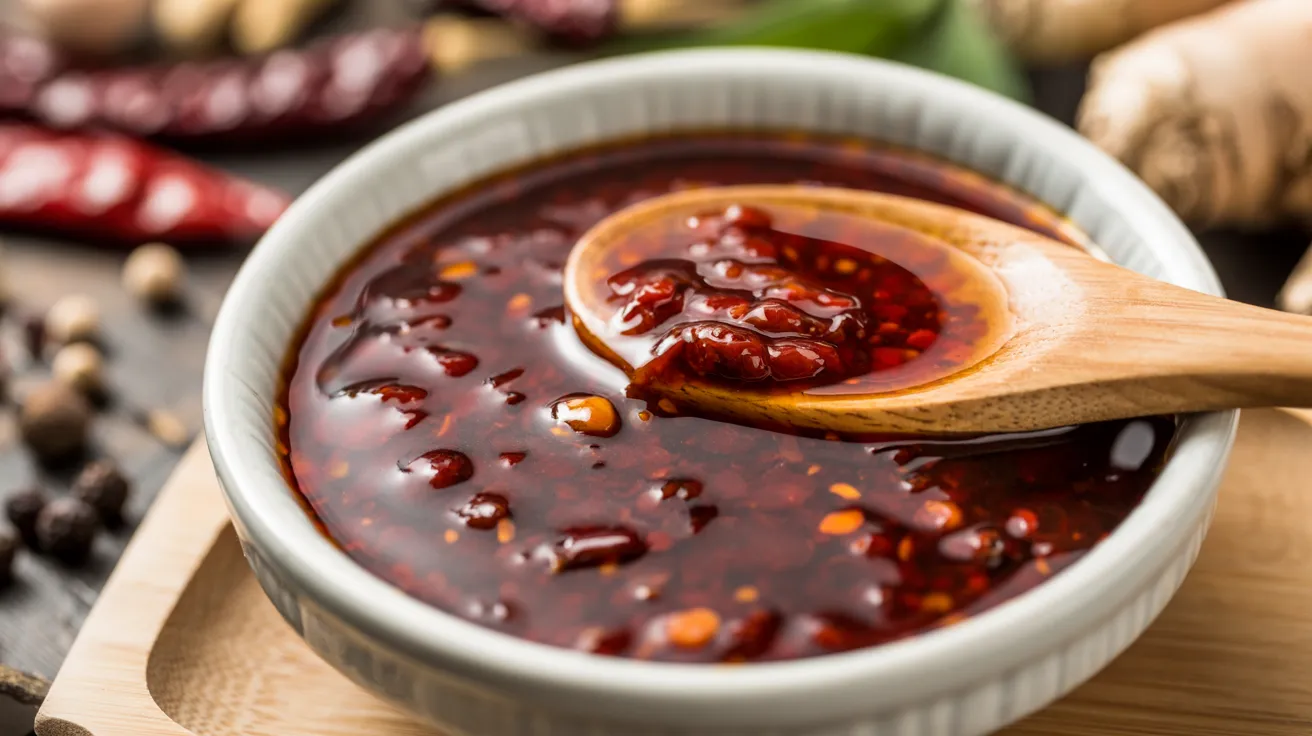Key Takeaways:
- Create authentic Tobanjan Sauce in just 20 minutes with simple ingredients
- This spicy, umami-rich Tobanjan Sauce transforms ordinary dishes into restaurant-quality meals
- Homemade Tobanjan Sauce stays fresh for up to 2 weeks — outlasting store-bought versions
- Perfect base for soups, stir-fries, and marinades (suitable for vegan and gluten-free diets)
Why Your Kitchen Needs Homemade Tobanjan Sauce
Ever tasted a dish that made your taste buds dance with joy? That’s the magic of Tobanjan Sauce. This spicy, fermented bean paste from Sichuan has become a secret weapon in kitchens worldwide, but many home cooks feel intimidated when trying to make it themselves.
Tobanjan Sauce delivers that perfect balance of heat and umami that store-bought versions simply can’t match. The depth of flavor in homemade Tobanjan Sauce will forever change how you approach Asian cooking. Once you taste this fresh version, you’ll never go back to those jars gathering dust in your pantry.
Ready to transform your cooking? Let’s make this four-person batch of Tobanjan Sauce that will take your meals from boring to bold!
Tobanjan Sauce Nutrition Profile
| Nutrient | Amount per Serving | % Daily Value |
|---|---|---|
| Calories | 45 | 2% |
| Total Fat | 1.5g | 2% |
| Sodium | 480mg | 20% |
| Carbohydrates | 8g | 3% |
| Fiber | 2g | 8% |
| Protein | 3g | 6% |
| Vitamin C | 8mg | 9% |
| Iron | 1.2mg | 7% |
Percent Daily Values based on a 2,000 calorie diet
What You’ll Need for Perfect Tobanjan Sauce
Tobanjan Sauce Ingredients
| Ingredient | Measurement | Notes |
|---|---|---|
| Fermented broad beans | 1 cup | Finely chopped |
| Red chili peppers | 6-8 medium | Deseeded for less heat if preferred |
| Garlic | 4 cloves | Minced |
| Ginger | 1 inch piece | Finely grated |
| Sichuan peppercorns | 1 tablespoon | Lightly crushed |
| Salt | 1 teaspoon | Adjust to taste |
| White pepper | ½ teaspoon | Optional |
| Vegetable oil | 3 tablespoons | High smoke point oil preferred |
| Rice vinegar | 1 tablespoon | For brightness |
| Sugar | ½ teaspoon | Balances heat |
Kitchen Tools for Tobanjan Sauce
| Tool | Purpose |
|---|---|
| Food processor | For blending ingredients |
| Wok or heavy pan | For cooking the sauce |
| Wooden spoon | For stirring |
| Measuring cups/spoons | For accurate measurements |
| Heat-resistant container | For storage |
| Cutting board | For preparation |
| Sharp knife | For chopping |
| Kitchen gloves | For handling chilies |
| Paper towels | For drying ingredients |
Substitutions for Tobanjan Sauce Ingredients
Can’t find some ingredients? Try these swaps:
- Fermented broad beans: Red miso paste (will change flavor profile but works in a pinch)
- Sichuan peppercorns: Black peppercorns (minus the numbing effect)
- Fresh chilies: Dried red chili flakes (2-3 tablespoons)
- Rice vinegar: Apple cider vinegar
If you enjoy exploring Asian condiments, you might also want to check out my detailed guide on Hoisin Sauce, which pairs beautifully with Tobanjan Sauce in many recipes.
Detailed Tobanjan Sauce Recipe Instructions for Beginners
Prep Time: 10 minutes
Cook Time: 10 minutes
Total Time: 20 minutes
Servings: 4 persons (approximately 1 cup of sauce)
Preparation Phase for Tobanjan Sauce
- Set up your workspace
- Clear your countertop to give yourself plenty of room
- Place all ingredients on one side of your workspace
- Position your cutting board in the center
- Keep measuring cups and spoons within easy reach
- Have a small bowl ready for discarded seeds and stems
- Line up your storage container nearby for the finished sauce
- Gather and measure all ingredients
- Take out all ingredients from your refrigerator and pantry
- Use separate small bowls to measure each ingredient
- Label each bowl if you’re new to these ingredients
- Keep ingredients that will be used together in the same area
- Double-check measurements against the recipe list
- Take a photo of your mise en place if helpful for future reference
- Prepare the chili peppers
- Put on kitchen gloves to protect your hands
- Rinse the chili peppers under cold water
- Pat them dry with paper towels
- Cut off the stems and discard
- Slice each pepper lengthwise
- Using the tip of your knife, carefully scrape out the seeds and white membrane
- For less heat, remove all seeds; for more heat, leave some in
- Chop the peppers into small pieces (approximately ¼ inch)
- Transfer to a clean bowl and set aside
- Wash your knife and cutting board immediately to prevent cross-contamination
- Prepare the fermented broad beans
- Open the package of fermented broad beans
- If they appear overly salty, rinse them briefly under cold water
- Drain thoroughly in a colander
- Spread on paper towels and pat dry
- Chop the beans into small pieces using your knife
- If using a food processor, pulse 3-4 times for a coarse texture
- Transfer to a clean bowl and set aside
- Prepare the aromatics
- Peel the garlic cloves by gently crushing with the flat side of your knife
- Mince the garlic into very fine pieces
- Peel the ginger using the edge of a spoon
- Grate the ginger using a microplane or fine grater
- If you don’t have a grater, mince the ginger as finely as possible
- Place the Sichuan peppercorns in a small plastic bag
- Gently crush them using a rolling pin or the bottom of a heavy pan
- Transfer all aromatics to separate small bowls
Cooking Phase for Tobanjan Sauce
- Heat your pan properly
- Place your wok or heavy-bottomed pan on the stove
- Turn the heat to medium
- Add the vegetable oil to the cold pan
- Allow the oil to heat until it shimmers but doesn’t smoke
- Test the oil temperature by adding one Sichuan peppercorn – it should sizzle gently
- CAUTION: Be prepared for strong aromas once you begin cooking
- Keep a lid nearby in case you need to quickly cover the pan
- Toast the Sichuan peppercorns
- Add all the crushed Sichuan peppercorns to the hot oil
- Stir continuously using your wooden spoon
- Toast for exactly 30 seconds – use a timer if helpful
- The peppercorns should become fragrant but not burn
- If they start to darken too quickly, lower the heat
- Move them around constantly to prevent burning
- TIP: Keep your face away from the pan to avoid eye irritation
- Add the garlic and ginger
- Add the minced garlic and grated ginger to the pan
- Lower heat slightly if necessary
- Stir continuously for 60 seconds
- Keep the aromatics moving to prevent burning
- The mixture should become very fragrant
- The garlic should soften but not brown
- If it starts to brown, immediately lower the heat
- TIP: Have your next ingredients ready to add
- Incorporate the chili peppers
- Add all the prepared chili peppers to the pan
- Stir immediately to combine with the aromatics
- Continue stirring for 2 minutes
- The peppers should begin to soften and release their color
- You’ll notice the oil taking on a reddish hue
- Maintain medium heat throughout this process
- SAFETY NOTE: Ensure good ventilation and avoid touching your face
- If the mixture begins to smoke, lower heat immediately
- Add the fermented broad beans
- Add all the chopped fermented broad beans to the pan
- Stir thoroughly to combine with the chili pepper mixture
- Reduce heat to medium-low
- Continue stirring for 3-4 minutes
- The beans should begin to break down slightly
- The mixture will become more cohesive
- TIP: Use your wooden spoon to press some beans against the side of the pan to help them break down
- The oil should begin to take on the flavors of all ingredients
- Season the Tobanjan Sauce
- Sprinkle the salt evenly across the mixture
- Add the white pepper if using
- Sprinkle the sugar evenly across the surface
- Stir thoroughly to incorporate all seasonings
- Pour the rice vinegar around the edges of the pan
- Stir immediately to distribute the vinegar
- Allow the mixture to simmer for 2 more minutes
- Stir occasionally during this time
- The vinegar should mostly evaporate, leaving flavor behind
- TIP: If the mixture appears too dry, add 1 tablespoon of water
Finishing Phase for Tobanjan Sauce
- Check the consistency
- After cooking, your Tobanjan Sauce should be thick but slightly pourable
- Test by lifting your wooden spoon – the sauce should slowly drip off
- If too thick, add 1 tablespoon of water and stir to combine
- If too thin, cook for 1-2 more minutes to reduce further
- The oil may separate slightly – this is normal and good
- TIP: The sauce will thicken more as it cools
- Taste and adjust your Tobanjan Sauce
- Turn off the heat completely
- Allow the sauce to cool for 1 minute
- Using a clean spoon, taste a very small amount
- CAUTION: The sauce will be hot and spicy
- Have a glass of water or milk nearby
- Evaluate the balance of flavors:
- If not salty enough, add ¼ teaspoon more salt
- If not spicy enough, add a pinch of chili flakes
- If too spicy, add ¼ teaspoon more sugar
- If too salty, add ¼ teaspoon more vinegar
- Make only one adjustment at a time
- Stir and taste again before making additional adjustments
- NOTE: The flavors will develop further as the sauce cools
- Cool and transfer your Tobanjan Sauce
- Remove the pan from heat completely
- Allow the sauce to cool in the pan for 5-10 minutes
- Stir occasionally during cooling
- Prepare your storage container by ensuring it’s clean and dry
- Once moderately cooled, transfer the sauce to your container
- Use a silicone spatula to get every last bit
- Leave a small gap at the top of the container for expansion
- Do not cover until completely cooled to room temperature
- Once cooled, seal tightly with a lid
- Label with the date of preparation
- TIP: If you see oil rising to the top as it cools, this is normal and helps preserve the sauce
For those who enjoy other Asian-inspired sauces, my Nanban Sauce recipe makes an excellent companion to dishes where you’ve used Tobanjan Sauce.

Troubleshooting Your Tobanjan Sauce
Common Issues and Solutions
Sauce is too spicy
- Add ½ teaspoon more sugar and stir thoroughly
- Mix in 1 tablespoon tomato paste to dilute the heat
- Serve with cooling sides like cucumber or yogurt
- Next time, remove all seeds and membranes from chilies
Sauce is too salty
- Add ½ teaspoon more sugar to balance the flavors
- Mix in 1 tablespoon water and 1 teaspoon vinegar
- Add a small amount of cooked, mashed sweet potato to absorb salt
- In the future, rinse the fermented beans more thoroughly
Sauce burned during cooking
- Don’t use the burned portion – it will taste bitter
- If the whole batch is affected, unfortunately, you’ll need to start over
- Next time, use lower heat throughout
- Stir more frequently, never leaving the pan unattended
Sauce is too thick
- While the sauce is still warm, add water 1 teaspoon at a time
- Stir well between each addition
- Stop when you reach desired consistency
- Remember it will thicken more when refrigerated
Sauce is too thin
- Return to medium-low heat
- Simmer for 2-3 more minutes, stirring constantly
- If still too thin, add ½ teaspoon cornstarch mixed with 1 teaspoon cold water
- Stir until thickened, then cool again
Variations & Substitutions for Tobanjan Sauce
Regional Variations
- Japanese Style Tobanjan
- Add 1 tablespoon mirin (sweet rice wine)
- Reduce chili amount by half for milder heat
- Increase sugar to 1 teaspoon for slightly sweeter profile
- Add ½ teaspoon sesame oil at the end of cooking
- Korean-Inspired Tobanjan Variation
- Add 1 tablespoon gochujang (Korean chili paste)
- Mix in 1 teaspoon sesame oil after cooling
- Sprinkle with 1 teaspoon toasted sesame seeds
- Add 1 teaspoon honey for sweetness
- Thai-Influenced Tobanjan Fusion
- Add 1 tablespoon fish sauce (or soy sauce for vegan version)
- Mix in 1 tablespoon fresh lime juice at the end
- Add 1 teaspoon palm sugar or brown sugar
- Include 1 tablespoon chopped fresh cilantro
Looking for something with a different flavor profile? My Rendang Sauce recipe offers a wonderful alternative when you want to explore Southeast Asian flavors.
Storage & Reheating Your Tobanjan Sauce
Proper Storage Methods
- Refrigeration:
- Store in an airtight glass or plastic container
- Keep refrigerated for up to 2 weeks
- A thin layer of oil on top helps preserve freshness
- Always use clean utensils when scooping out portions
- Freezing:
- Portion into ice cube trays (1 tablespoon per cube)
- Freeze until solid (approximately 4 hours)
- Transfer frozen cubes to freezer bags
- Label with date and contents
- Use within 3 months for best flavor
- Thaw in refrigerator or use frozen cubes directly in hot dishes
- Room Temperature:
- Not recommended for more than 2 hours
- Never leave out overnight
- If left at room temperature too long, discard for safety
Using Leftover Tobanjan Sauce
- No Reheating Needed:
- Use straight from the refrigerator for most applications
- Allow to sit at room temperature for 10 minutes to take the chill off
- Stir well before using
- If Frozen:
- Thaw overnight in refrigerator for best results
- For immediate use, place frozen cubes directly into hot soups or stir-fries
- One cube equals approximately 1 tablespoon of sauce
- Revitalizing Separated Sauce:
- If oil separates during storage, stir well before using
- If sauce becomes too thick, add a few drops of water
- If too dry, add a few drops of oil and stir thoroughly
Safety Notes & Tips for Tobanjan Sauce
Safety First
- Handling Chilies:
- Always wear gloves when handling hot peppers
- Avoid touching your face, especially eyes and nose
- Wash hands thoroughly with soap after handling, even if you wore gloves
- Keep separate cutting boards for chilies to prevent cross-contamination
- Ventilation:
- Ensure kitchen is well-ventilated during cooking
- Turn on exhaust fan or open windows
- The cooking process releases compounds that can irritate eyes and lungs
- Consider cooking when children or sensitive individuals are not nearby
- Eye Protection:
- If you have sensitive eyes, wear glasses or goggles
- Keep a clean towel nearby to wipe hands before touching your face
- If chili oil gets in eyes, flush with cool water for 15 minutes
- Allergies:
- Contains fermented beans – check for soy allergies
- If serving to guests, always mention ingredients
- Label clearly if giving as a gift
Pro Tips for Perfect Tobanjan Sauce
- Authentic Flavor:
- Toast Sichuan peppercorns in a dry pan before crushing for deeper flavor
- Source fermented broad beans from Asian grocery stores for best results
- Use freshly harvested chilies when possible
- Balance the five flavors: spicy, salty, sweet, sour, and umami
- Batch Cooking:
- Double the recipe and freeze portions for quick meal additions
- Make different heat levels for various family members
- Label clearly with heat level and date
- Gift Giving:
- Package in small decorative jars with custom labels
- Include recipe cards for how to use the sauce
- Make sure recipients know proper storage requirements
- Mention shelf life (2 weeks refrigerated)
- Perfect Pairings:
- Use with pork, beef, chicken, tofu, or vegetables
- Add to ramen or udon soup bases
- Mix with mayonnaise for sandwiches and burgers
- Blend with butter for a compound butter to top steaks or fish
- Heat Management:
- Remove more seeds for milder sauce, leave more for extra heat
- The heat level will increase slightly over the first few days of storage
- Start with half the recommended chilies if sensitive to spice
- Have dairy products on hand when tasting (they neutralize capsaicin)
Ways to Use Your Tobanjan Sauce
- Stir 1 teaspoon into soups for instant depth and heat
- Mix 1 tablespoon with 2 tablespoons mayonnaise for a spicy sandwich spread
- Use as a marinade for meats and tofu (1 tablespoon per pound)
- Add 1 teaspoon to stir-fries in the last minute of cooking
- Blend 1 tablespoon with 4 tablespoons softened butter for a compound butter
- Mix 1 teaspoon with 2 tablespoons soy sauce for a quick dumpling dip
- Stir ½ teaspoon into scrambled eggs for a flavor boost
- Add ¼ teaspoon to salad dressings for extra zing
Remember: Tobanjan Sauce is potent – a little goes a long way! Start with small amounts and adjust to your taste preference. Your homemade version will have more vibrant flavor than store-bought, so you may need less than recipes call for.




